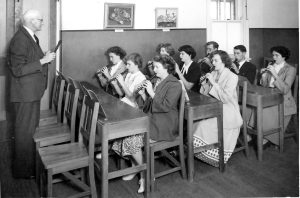By Geoff Wharton
Coen is one of the oldest European place-names in Queensland. The name ‘de rivier Coen’ (Coen River) first appeared on a chart compiled by the Dutch sailor Arent Martensz de Leeuw of the discoveries of the Pera expedition along the coast of western Cape York Peninsula in 1623. Hence this is one of the oldest European place-names in Queensland. The river, which may have been the river now known as the Archer, probably was named after Jan Pieterszoon Coen, Governor-General of the Verenigde Oost-Indische Compagnie (VOC – United East India Company), often referred to as the Dutch East India Company.
When Matthew Flinders visited the eastern Gulf of Carpentaria waters in November 1802, he landed at a river on western Cape York Peninsula that he identified as the Coen River from an old Dutch chart. The name Coen River continued to be applied to that location on all charts and maps until 1894, but in 1881 a second Coen River appeared on an official Queensland map some 250 kilometres to the south-east. Until land surveys were conducted by John Thomas Embley for the Queensland Surveyor-General during the 1880s, the exact location of many Peninsula rivers was uncertain.
According to geologist R.L. Jack, a party of fifteen prospectors travelled up to the Central Peninsula region in 1876. Five of these men remained near the site of today’s Coen township and found gold in about September that year. Further expeditions were mounted in 1878, following announcement of the gold find, when journalist R. Spencer Browne compiled a special edition of the Cooktown Herald. In his annual report for 1878, the Under Secretary for Mines, Geo. Lukin, noted that the gold discovery ‘was on the Coen River, about 200 miles north of the Palmer, and to which in the early months of the year a considerable population had gathered, but at the close of the year it was almost entirely deserted’. The Mining Warden on the Palmer Gold Fields, Sellheim, referring to the mining area as ‘the Coen’ wrote pessimistically that the mining ground ‘had been talked of for about twelve months previously, but was always understood to be excessively poor’.
It appears that the cartographer who produced Queensland’s first 16 mile series map in 1881 was advised that a river flowed near the Coen gold diggings. The cartographer annotated the map with the sentence ‘Locally known as Coen River’. By the time the next edition of the map was published in 1885, the name South Coen River was applied to the river which rises east of today’s Coen township and flows into the Archer River in the west. The course of the river had just been surveyed by J. T. Embley. R.L. Jack indicates that it was Embley who gave the South Coen River its name and this is confirmed by Embley’s survey plan of his traverse of the river.
During the 1880s and early 1890s, the names Coen (for the gold diggings) and South Coen River were both used in official records. A police station was established at Coen in about 1885 and was staffed by one Sub-Inspector, two Constables and nine Aboriginal Trackers and Troopers.
The route for an electric telegraph line which connected North Queensland with the top of Cape York Peninsula was surveyed by John Bradford in 1883. During construction of the line, telegraph repeater stations were built at intervals of approximately 100 to 120 kilometres along the line and served as depots/barracks for line repair crews as well as post and telegraph offices. The Coen Telegraph Station opened on 29 December 1886 and the telegraph line between Fairview and Paterson near Cape York was opened on 25 August 1887.
Further mineral discoveries attracted more miners in 1885, when the Mining Warden for the Palmer Gold Field, Howard St George, reported that on ‘the Coen, which forms part of the Palmer mineral district, several leases have been applied for, with the intention of working for silver.’
These new developments eventually prompted the Queensland Mines Department to decide that a gold field should be declared under the Goldfields Act 1874 to control the various mining operations. The Coen River Gold Field covering an area of 43¼ square miles within the ‘watershed of the South Coen River above the crossing of the road from Rokeby to Lalla Rookh’ was gazetted on 20 August 1892.
It soon became apparent to Queensland Government officials that there were two Coen rivers in the western Cape York Peninsula region: the Coen named by Flinders and the South Coen which rose in the southern end of the McIlwraith Range – near the mining township of Coen – and drained into the Archer River at 13º 20′ South and 141º 42′ East.
John Douglas, the Government Resident on Thursday Island, drew attention to the issue in his annual report for 1892-1893. W.E. Parry-Okeden – then Principal Under Secretary of the Queensland Colonial Secretary’s Office – wrote to the Under Secretary of Public Lands advising that Douglas had requested that the Coen River be re-named “Pennefather” (after the then Comptroller General of Prisons) to avoid confusion with the South Coen River and Parry-Okeden suggested that the latter river be re-named the Coen River.
On 9 June 1894 a notice from the Department of Public Lands in the Queensland Government Gazette indicated the change in the two place-names and these were incorporated on the Queensland Surveyor-General’s 16 mile series map three years later. But the Queensland Government forgot to notify the British Admiralty, so the coastal hydrographic charts continued to show the name Coen River for the northern river.
Eventually in 1958, former Royal Australian Navy hydrographer, T. F. Roberts, wrote to the Surveyor-General of Queensland to suggest that a number of place-names on western Cape York Peninsula which varied between those shown on Admiralty charts and other maps should be renamed for the sake of uniformity.
Roberts noted that Flinders had wrongly identified the Coen River, ‘now shown on Land Maps as Pennefather and originally charted by Tasman as Prince River. It is always known locally by both Europeans and Natives as Coen River probably as communication is generally by sea and the Adm.[iralty] Chart used’. It appears that Roberts’ suggestion for standardisation of the river’s name was heeded by the Royal Australian Navy (RAN), as a request was sent from the RAN to the British Admiralty in 1960 requesting that the sailing directions should be amended to show ‘Pennefather (Coen) River’.
The name Pennefather (Coen) River first appeared on British Admiralty Chart 445 ‘Series C8 bearing Large Corrections to 5 November 1965’. Finally in December 1967 the name Coen was officially superseded by Pennefather in a table of ‘New and altered names’ in the Australia Pilot.
The author thanks Kaye Nardella, Curator, and Bill Kitson PSM, former Curator, Lands, Mapping and Surveying Museum, Department of Environment and Resource Management, for their research assistance and advice.

